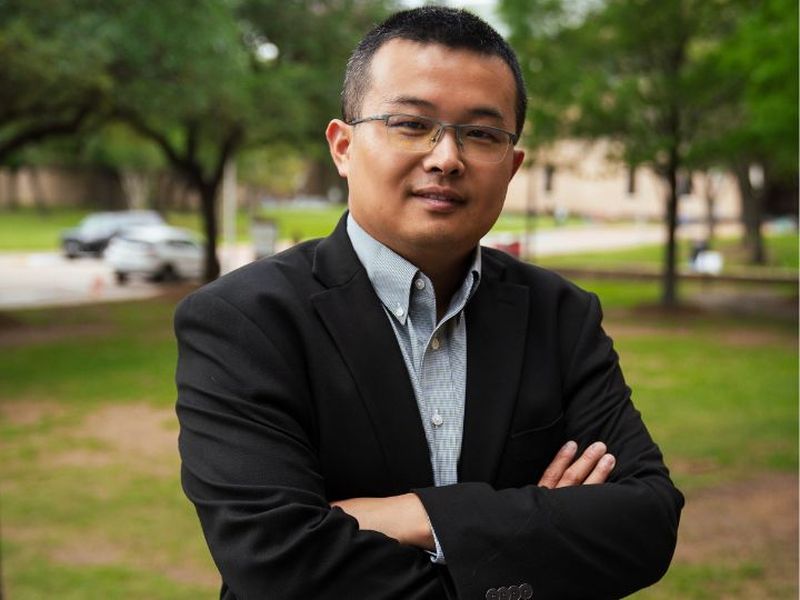Assistant Professor of Mechanical & Aerospace Engineering Ben Xu has received a National Science Foundation CAREER award for $598,991 for his research to understand bubble dynamics in hydrogels.
His project, “Multiscale Understanding of Laser-Induced Bubble Dynamics and the Mechanism of Resultant Jet Flow in Thin-Shearing Hydrogels,” seeks to advance the understanding of bubble dynamics in hydrogels — which are widely used in biomedical and energy applications — and their interactions with lasers, focusing on how these interactions drive material behavior and jet flow formation.
This year marked Xu’s third submission for the award, and indeed, the third time was the charm.
“I’ve been working on this topic since 2018, so that’s six years of effort,” he said. “I’ve kept working on this topic, improving it, refining the hypothesis, and fortunately everything went well this time. When I got the award email… It was a relief.”
While significant research has been conducted on interactions of lasers with water and other Newtonian fluids, growing use of laser-assisted bioprinting (LAB) has highlighted our need to better understand the behavior of complex materials like hydrogels.
Laser-assisted bioprinting (LAB) uses lasers to precisely deposit materials, such as hydrogels embedded with cells, onto a surface substrate. In this process, hydrogels serve as a carrier, or "bioink," encapsulating bioactive cells to enable controlled placement and create functional biological structures.
The laser-induced bubble dynamics and subsequent hydrogel jet flow play a critical role in determining the precision and quality of the printing process. Understanding these dynamics is essential for optimizing printing processes and ensuring reliable fabrication of functional biological structures.
Unlike Newtonian fluids, which maintain a constant viscosity regardless of applied strain, non-Newtonian fluids — such as hydrogels — exhibit viscosity that changes with variations in shear rate. This means the behavior of non-Newtonian fluids depends on the forces acting upon them, adding a layer of complexity to the study of laser-material interactions in these systems.
“We don’t yet fully understand how the short pulse, high-frequency laser interacts with the hydrogel, or how and when the initial bubble is formed within a thin hydrogel layer,” Xu said. “Once we gain a clearer idea about the bubble and jet flow, we’ll be able to better control the hydrogel printing process.”
He added that “these processes are happening at such incredibly small scales, both temporally and spatially, that our current understanding remains limited.”
During his undergraduate studies, Xu developed a deep fascination with the cavitation phenomenon while interning at a large hydropower plant.
“When I saw the large holes and damage on the turbine blades caused by cavitation, I became deeply intrigued by the complexity of this phenomenon,” Xu said. This experience sparked his curiosity about fluid mechanics and the mechanisms driving bubble formation and dynamics.
“At the very beginning, this work was driven by my curiosity about how the bubble was generated when a laser interacts with hydrogels,” Xu said. “I initially hypothesized that these are cavitation bubbles. However, I later realized the laser-induced hydrogel bubble formation is far more complex than simple cavitation. Instead, the process involves a combination of multiphysics phenomena, including thermal effects, phase transitions, and plasma generation. Now we get to test the new hypothesis using this CAREER funding.”
“Why does this work? Why can the laser induce bubbles and jet flow in hydrogels?” Xu continued. “Once we clearly understand this process, we will have opportunities to develop the next generation of bioprinting technologies, significantly enhancing printing efficiency and enabling fabrication of multifunctional materials for complex structures.”
Xu is further interested in using this research to develop a new academic course focusing on thermofluids sciences in advanced manufacturing processes.
“We don’t have that course in our mechanical engineering curriculum right now, and I think it would be great for me to help develop some new courses in the department to help our graduate students improve their understanding,” he said.
Alongside this research, Xu and his team plan to develop test kits for local K-12 classrooms, collaborating with science teachers to engage students in hands-on activities that explore principles of non-Newtonian fluids and demonstrate how bubbles can play a role in engineering and manufacturing.
“I want to trigger that curiosity for the next generation,” Xu said.
